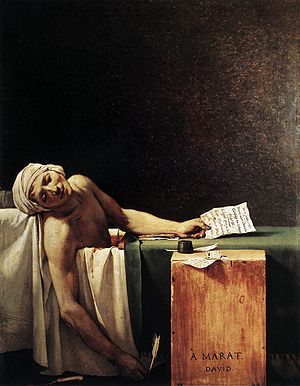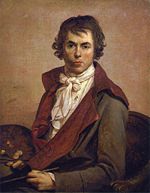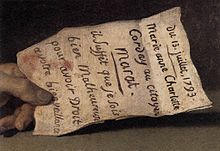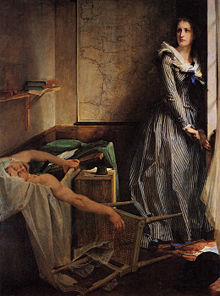- The Death of Marat
-
La Mort de Marat 
Artist Jacques-Louis David Year 1793 Type oil on canvas Dimensions 162 cm × 128 cm (64 in × 50 in) Location Royal Museums of Fine Arts of Belgium The Death of Marat (French: La Mort de Marat) is a 1793 painting in the Neoclassical style by Jacques-Louis David, and is one of the most famous images of the French Revolution. This work depicts the radical journalist Jean-Paul Marat lying dead in his bath on 13 July 1793 after his murder by Charlotte Corday. Corday, who was from a minor aristocratic family, blamed Marat for the September Massacres and feared an all out civil war, claimed "I killed one man to save 100,000." It has been described as the first modernist painting.
Contents
Context
Jean-Paul Marat (May 24, 1743 – July 13, 1793), was a Swiss-born French physician, philosopher, political theorist and scientist best known as a radical journalist and politician from the French Revolution.
Marat often sought the comfort of a cold bath to ease violent itchings due to a skin disease long said to have been contracted years earlier, when he was forced to hide from his enemies in the Paris sewers.
David was a close friend of Marat, as well as a strong supporter of Robespierre and the Jacobins. Due to his difficulty speaking (he had a benign but large facial tumor, the result of an injury sustained while fencing), David was overwhelmed by their natural capacity for convincing crowds with their speeches. Determined to memorialize his friend, David painted this portrait of Marat.
Style
Marat's figure is idealized. For example, the painting contains no sign of his skin problems. David, however, drew other details from his visit to Marat's residence the day before the assassination: the green rug, the papers, and the pen. David promised his peers in the National Convention that he would later depict their murdered friend invocatively as "écrivant pour le bonheur du peuple" (writing for the good of the people). The Death of Marat is designed to commemorate a personable hero. Although the name Charlotte Corday can be seen on the paper held in Marat's left hand, she herself is not visible. Close inspection of this painting shows Marat at his last breath, when Corday and many others were still nearby (Corday did not try to escape). Therefore, David intended to record more than just the horror of martyrdom.[1] In this sense, for realistic as it is in its details, the painting, as a whole, from its start, is a methodical construction focusing on the victim, a striking set up regarded today by several critics as an "awful beautiful lie"— certainly not a photograph in the forensic scientific sense and barely the simple image it may seem (for instance, in the painting, the knife is not to be seen where Corday had left it impaled in Marat's chest, but on the ground, beside the bathtub).
The Death of Marat has often been compared to Michelangelo's Pietà. Note the elongated arm hanging down in both works. David admired Caravaggio's works, especially Entombment of Christ, which mirrors The Death of Marat's drama and light.
David sought to transfer the sacred qualities long associated with the monarchy and the Catholic Church to the new French Republic. He painted Marat, martyr of the Revolution, in a style reminiscent of a Christian martyr, with the face and body bathed in a soft, glowing light. As Christian art had done it from its beginning, David also played with multileveled references to classical art. Suggestions that Paris could compete with Rome as capital and mother city of the Arts and the idea of forming a kind of new Roman Republic appealed to French Revolutionaries, who often formed David's audience.
Later history
 One of two versions of Death of Marat made by Edvard Munch in 1907
One of two versions of Death of Marat made by Edvard Munch in 1907
Widely admired during the Terror whose leaders ordered several copies of the original work (copies made in 1793–1794 by David's pupils to serve propaganda), The Death of Marat slowly ceased to be 'frontpage history' after Robespierre's overthrow and execution. At his request, it was returned to David in 1795, himself being prosecuted for his involvement in the Terror as a close friend of Robespierre (he would have to wait for Napoleon's rise to become prominent in the arts once more). From 1795 to David's death, the painting languished in obscurity. During David's exile in Belgium, it was hidden, somewhere in France, by Antoine Gros, David's dearest pupil. In 1826 (and later on), the family tried to sell it, with no success at all. It was rediscovered by the critics in the mid-nineteenth century, especially by Charles Baudelaire whose famous comment in 1846 became the starting point of an increased interest among artists and scholars. In the 20th century, the painting inspired several painters (among them Picasso and Munch who delivered their own versions), poets (Alessandro Mozzambani) and writers (the most famous being Peter Weiss with his play Marat/Sade).
The original painting is currently displayed at the Royal Museum of Fine Arts in Brussels, being there as a result of a decision taken by the family to offer it, in 1886, to the city where the painter had lived quietly and died in exile after the fall of Napoleon. Some of the copies (the exact number of those completed remains uncertain) made by David's pupils (among them, Serangeli and Gérard) survived, notably visible in the museums of Dijon, Reims, and Versailles. The original letter, with bloodstains and bath water marks still visible, has survived and is currently intact in the ownership of Robert Lindsay, 29th Earl of Crawford.[2]
Other artists have also depicted the death of Marat, sometimes long after the facts, whose works refer or not to David's masterpiece. Among these later works, the Charlotte Corday by Paul Jacques Aimé Baudry, painted in 1860, during the Second Empire, when Marat's "dark legend" (the angry monster insatiably hungry for blood) was widely spread among educated people, depicts Charlotte Corday as a true heroine of France, a model of virtue for the younger generations. The versions of Picasso and Munch are less trying to refer to the original context in itself than to confront modern issues with those of David, in terms of style.
Filmography
- In 1897, the Frenchman Georges Hatot directed La Mort de Marat. This early silent film made for the Lumière Company is a brief single-shot scene of the assassination of the revolutionary. A remarkable aspect[citation needed] of the print of this film available nowadays is that it is hand-coloured. Many early films were hand-painted, including those by the Lumière Company.
- Danton (A. Wajda, France, 1982) – Historical drama (several scenes in David's atelier, including one showing the painting of Marat's portrait).
- Derek Jarman's 1986 Caravaggio clearly quotes from the painting about 1 hour in. At the end of the scene the chronicler, head bound in a towel (but writing here with a typewriter), slouches back in his tub, one arm extended outside the tub.
Footnotes
- ^ Vaughan, William; Helen Weston (2000). Jacques-Louis David's 'Marat'. Cambridge University Press. pp. 16–17. ISBN 0-521-56337-2.
- ^ The Earl of Crawford has the largest collection of French revolutionary manuscripts in Scotland.
Bibliography
- Thibaudeau, M.A., Vie de David, Bruxelles (1826)
- Delécluze, E., Louis David, son école et son temps, Paris, (1855) re-edition Macula (1983) – First-hand testimony by a pupil of David
- David, J.L., Le peintre Louis David 1748–1825. Souvenirs & Documents inédits par J.L. David son Petit-Fils, ed. Victor Havard, Paris (1880)
- Holma, Klaus, David. Son évolution, son style, Paris (1940)
- Adhé mar Jean, David. Naissance du génie d'un peintre, ed. Raoul Solar, Paris (1953)
- Bowman, F.P., 'Le culte de Marat, figure de Jésus', Le Christ romantique, ed. Droz, Genève,pp. 62 sq. (1973)
- Wildenstein, Daniel et Guy, Documents complémentaires au catalogue de l’oeuvre de Louis David, Paris, Fondation Wildenstein (1973) – fondamental source to track all influences constituting David's visual culture
- Starobinski, Jean, 1789, les emblèmes de la raison, ed. Flammarion, Paris (1979)
- Schnapper, Antoine, David témoin de son temps, ed. Office du Livre, Fribourg (1980)
- Kruft, H.-W., "An antique model for David's Marat" in The Burlington Magazine CXXV, 967 (October 1983), pp. 605–607; CXXVI, 973 (April 84)
- Traeger, Jorg, Der Tod des Marat: Revolution des menschenbildes, ed. Prestel, München (1986)
- Thévoz, Michel, Le théâtre du crime. Essai sur la peinture de David, éd. de Minuit, Paris (1989)
- Guilhaumou, J., La mort de Marat, ed. Complexe, Bruxelles (1989)
- Mortier, R., 'La mort de Marat dans l'imagerie révolutionnaire', Bulletin de la Classe des Beaux-Arts, Académie Royale de Belgique, 6ème série, tome I, 10–11 (1990), pp. 131–144
- Simon, Robert, "David’s Martyr-Portrait of Le Peletier de Saint-Fargeau and the conundrums of Revolutionary Representation" in Art History, vol.14, n°4 (December 1991), pp. 459–487
- Sérullaz, Arlette, Inventaire général des dessins. Ecole française. Dessins de Jacques-Louis David 1748–1825, Paris (1991)
- David contre David, actes du colloque au Louvre du 6–10 décembre 1989, éd. R. Michel, Paris (1993) [M. Bleyl, "Marat : du portrait à la peinture d'histoire"]
- Malvone, Laura, "L'Évènement politique en peinture. A propos du Marat de David" in Mélanges de l'Ecole française de Rome. Italie et Méditerranée, n° 106, 1 (1994)
- Pacco, M., De Vouet à David. Peintures françaises du Musée d'Art Ancien, XVIIe et XVIIIe siècles, ed. MRBAB, Bruxelles (1994)
- Hofmann, Werner, Une époque en rupture 1750–1830, Gallimard, Paris (1995)
- Crow, T., Emulation. Making artists for Revolutionary France, ed. Yale University Press, New Haven London (1995)
- Monneret, Sophie, David et le néoclassicisme, ed. Terrail, Paris (1998)
- Robespierre, edited by Colin Haydon & William Doyle, Cambridge (1999)
- Lajer-Burcharth, E., Necklines. The art of Jacques-Louis David after the Terror, ed. Yale University Press, New Haven London (1999)
- Lee, S., David, ed. Phaidon, London (1999); * Aston, Nigel, Religion and Revolution in France, 1780–1804, McMillan, London (2000)
- Jacques-Louis David’s Marat, edited by William Vaughan & Helen Weston, Cambridge (2000)
- Rosenberg, Pierre & Louis-Antoine Prat, Jacques-Louis David 1748–1825. Catalogue raisonné des dessins, 2 volumes, éd. Leonardo Arte, Milan (2002)
- Idem, Peronnet, Benjamin, « Un album inédit de David », Revue de l’Art, n°142, (2003–2004) pp. 45–83
- Coquard, Olivier, "Marat assassiné. Reconstitution abusive" in Historia Mensuel, n°691 (juillet 2004)
- Vanden Berghe, Marc & Ioana Plesca, Nouvelles perspectives sur la Mort de Marat: entre modèle jésuite et références mythologiques, Bruxelles (2004) / New perspectives for David's Death of Marat, Brussels (2004) art-chitecture.net
- Idem, Lepeletier de Saint-Fargeau sur son lit de mort par Jacques Louis-David : saint Sébastien révolutionnaire, miroir multiréférencé de Rome, Brussels (2005) art-chitecture.net
- Sainte-Fare Garnot, N., Jacques-Louis David 1748–1825, Paris, Ed. Chaudun (2005)
- Johnson, Dorothy, Jacques-Louis David: New Perspectives, University of Delaware Press (2006)
- Guilhaumou, Jacques, La mort de Marat (2006) revolution-francaise.net
- Plume de Marat – Plumes sur Marat, pour une bibliographie générale, (Chantiers Marat, vol. 9–10), Editions Pôle Nord, Bruxelles (2006)
- Angelitti, Silvana, "La Morte di Marat e la Pietà di Michelangelo" in La propaganda nella storia, sl, (sd), e-torricelli.it
- Pesce, Luigi, Marat assassinato : il tema del braccio della morte : realismo caravagesco e ars moriendi in David, s.ed., sl, (2007) steadyoffload.com
Jacques-Louis David Works The Death of Marat · Portrait of Count Stanislas Potocki · Oath of the Horatii · The Death of Socrates · The Lictors Bring to Brutus the Bodies of His Sons · The Intervention of the Sabine Women · Napoleon at the Saint-Bernard Pass · The Coronation of Napoleon · Belisarius Begging for Alms · Portrait of Madame Récamier · Portrait of Pope Pius VII · Leonidas at Thermopylae · Napoleon in His Study · Portrait of Antoine-Laurent Lavoisier and his wife · Mars Being Disarmed by Venus · Andromache Mourning Hector Categories:
Categories:- 1793 paintings
- 1793 events of the French Revolution
- Jacques-Louis David paintings
- Collections of the Royal Museums of Fine Arts of Belgium
- Paintings depicting death
Wikimedia Foundation. 2010.


